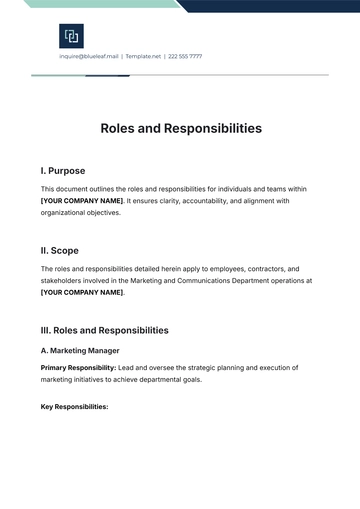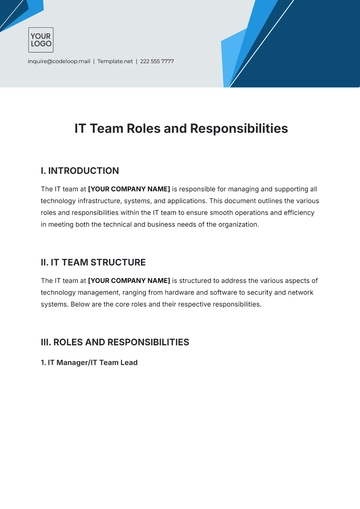Free Construction Roles and Responsibilities

I. INTRODUCTION
This document outlines the roles and responsibilities of key personnel involved in the construction process for projects managed by [YOUR COMPANY NAME]. The purpose is to ensure a clear understanding of each party's duties to guarantee project success, efficiency, and safety.
II. PROJECT MANAGER
The Project Manager is responsible for overseeing the entire construction process from initiation to completion. This includes ensuring that the project stays on budget, on schedule, and within scope.
Responsibilities:
Oversee day-to-day project operations.
Coordinate between stakeholders, including contractors, architects, and clients.
Ensure project compliance with local regulations, building codes, and safety standards.
Monitor and manage the project budget and timelines.
Resolve issues or conflicts that arise during construction.
Ensure high-quality standards are maintained throughout the project.
III. CONSTRUCTION SUPERVISOR
The Construction Supervisor is in charge of supervising on-site construction activities and workers. They ensure that work is completed safely, efficiently, and according to the project specifications.
Responsibilities:
Supervise day-to-day construction activities.
Ensure workers are following safety protocols and regulations.
Monitor the progress of the work to ensure it meets project deadlines.
Report progress and challenges to the Project Manager.
Inspect construction work to ensure it complies with blueprints and quality standards.
Manage material and equipment on-site.
IV. SAFETY OFFICER
The Safety Officer ensures that all safety regulations are adhered to on the construction site. They are responsible for minimizing accidents and maintaining a safe work environment.
Responsibilities:
Implement and enforce safety regulations and procedures.
Conduct regular safety inspections and audits.
Train workers on proper safety procedures and equipment use.
Investigate accidents or near-miss incidents and propose corrective actions.
Ensure that the site complies with OSHA standards and any other relevant safety regulations.
V. ARCHITECT
The Architect is responsible for designing the project, providing technical specifications, and ensuring the design is adhered to throughout construction.
Responsibilities:
Develop project plans, designs, and blueprints.
Provide technical expertise during the construction phase.
Conduct site visits to ensure the design is being followed.
Collaborate with engineers and contractors to resolve design-related issues.
Ensure that designs meet aesthetic, functional, and regulatory requirements.
VI. ENGINEER
The Engineer is responsible for providing the technical and structural support required during the construction process. This includes calculations, assessments, and oversight on engineering-related matters.
Responsibilities:
Provide design and engineering calculations for structural, mechanical, electrical, and plumbing systems.
Conduct inspections and quality control tests.
Resolve any engineering challenges that arise during the construction process.
Collaborate with the architect and contractor to ensure the structure's integrity and functionality.
Ensure the project complies with relevant building codes and engineering standards.
VII. CONTRACTOR
The Contractor is responsible for managing and performing the actual construction work. This includes overseeing labor, subcontractors, and construction materials.
Responsibilities:
Manage subcontractors and laborers on-site.
Ensure construction is completed according to the project specifications and timeline.
Procure and manage materials and equipment for the project.
Maintain communication with the Project Manager and Construction Supervisor to report progress and challenges.
Ensure that all work is performed to the highest quality standards and complies with safety regulations.
VIII. SUBCONTRACTORS
Subcontractors are specialized professionals hired to perform specific tasks during the construction process, such as electrical, plumbing, or HVAC work.
Responsibilities:
Perform assigned tasks according to project specifications.
Ensure their work is completed on time and to the required standards.
Coordinate with the contractor and construction supervisor regarding scheduling and site needs.
Provide reports on work progress and any issues encountered.
Adhere to safety regulations and construction site protocols.
IX. CLIENT/OWNER
The Client or Owner is the individual or organization funding and receiving the construction project. They are responsible for making key decisions and approving major changes to the project.
Responsibilities:
Provide clear project expectations, objectives, and budget.
Approve project designs and major changes during construction.
Ensure timely payment for work completed.
Maintain communication with the Project Manager to receive updates on project status.
Review and sign off on project milestones and final completion.
X. CONCLUSION
Each role in the construction process is vital to ensuring that [YOUR COMPANY NAME] completes the project safely, on time, and within budget. By understanding these roles and responsibilities, all personnel can work together effectively to meet the project goals.
- 100% Customizable, free editor
- Access 1 Million+ Templates, photo’s & graphics
- Download or share as a template
- Click and replace photos, graphics, text, backgrounds
- Resize, crop, AI write & more
- Access advanced editor
This Construction Roles and Responsibilities Template from Template.net offers a customizable, professional format to outline key roles within construction projects. Editable in our AI Editor Tool, this template helps project managers and teams clearly define responsibilities. Tailor it to meet the specific needs of your construction projects for enhanced efficiency.





























